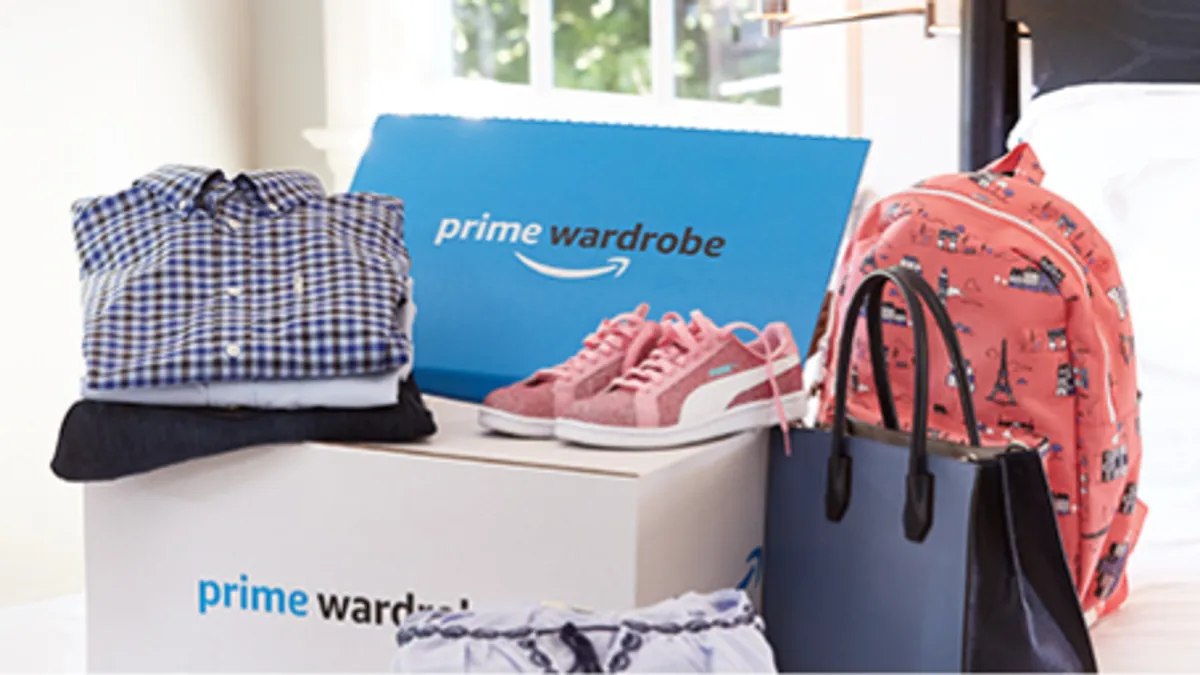Dive Brief:
-
Amazon Fashion is extending its invite-only Prime Wardrobe program to more Prime customers, the company told Retail Dive in an email on Thursday. The program, which allows shoppers to order and try clothes without paying first, hasn’t yet officially launched, a spokesperson said.
-
Invitations appear to be easy to get. Prime customers can request an invitation through the program's page, the spokesperson said. But in some cases no request needs to be made; that link simply tells a Prime member that they’ve been invited, Retail Dive found.
-
Certain apparel items are designated eligible for Prime Wardrobe orders, which must include three or more things. Customers can keep them for up to seven days and then return unwanted items. Delivery both ways is free.
Dive Insight:
Amazon launched its try-before-you-buy service last year, a shot across the bow to Stitch Fix. Both attempt to rationalize the tendency of e-commerce shoppers to order more than they intend to keep. Post-purchase solutions firm Narvar has said that, on average, 40% of those buying apparel and home goods online do at least occasionally buy more than they want.
Amazon has good reason to smooth out the shipping and return processes for its apparel shoppers and to its entice its Prime members to buy apparel. Prime members are already fueling the e-tailer's apparel sales growth, with nearly two-thirds saying they've shopped for clothing or footwear there in the past year, according to retail think tank Coresight Research.
Expect Amazon's private-label apparel to get the "Prime Wardrobe" designation early and often. The company's own ranges are the fourth most-bought clothing or footwear "brand" on Amazon.com, and one in nine Amazon apparel shoppers surveyed by Coresight had bought an Amazon-label item. Only Nike, Under Armour and Hanes ranked higher than Amazon's private labels, according to that research.
Younger shoppers "are ready to embrace a full Amazon Fashion experience," Coresight Research founder-CEO Deborah Weinswig wrote in that report.
While Amazon's apparel sales are already formidable and gaining, the e-commerce giant does have a few disadvantages. With no stores, shoppers can't get the immediate satisfaction of assessing fit and walking out with what they want, and they can't return their online orders (except at a handful of Kohl's stores). Narvar found that 22% of apparel shoppers won't make an online purchase if they don't have the option of returning to a store.
Prime Wardrobe and other try-before-buy programs may encourage more apparel orders and wrest some control of the process, but it's an expensive option, and many retailers may not be prepared for just how expensive it is, according to omnichannel retail management firm Brightpearl. More than 40% of retailers have seen an increase in "intentional returns" in the past year, and 44% said margins are being hit hard by handling and packaging returns. A full 70% said they expect to be squeezed further as the practice intensifies, according to Brightpearl research.














